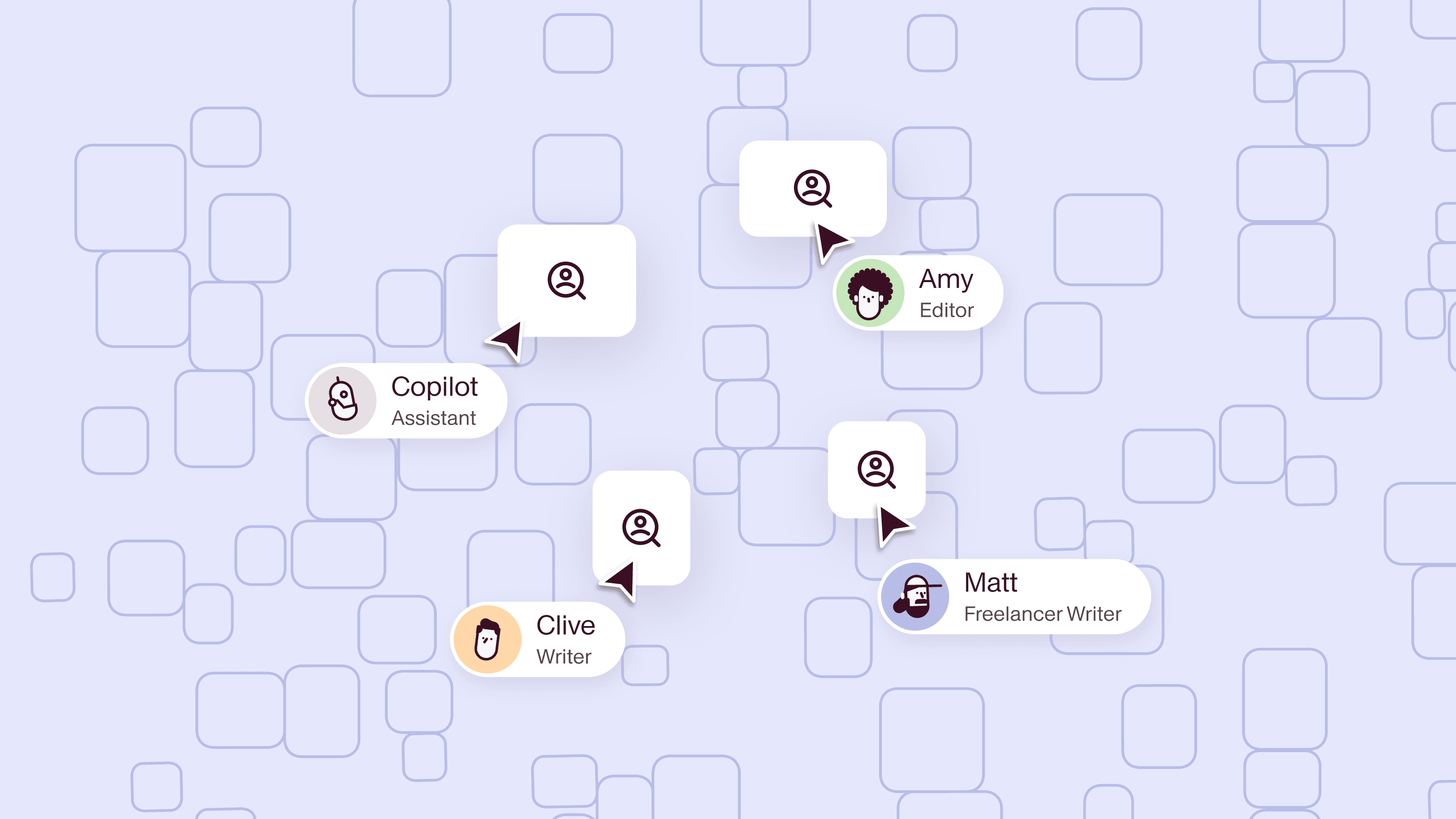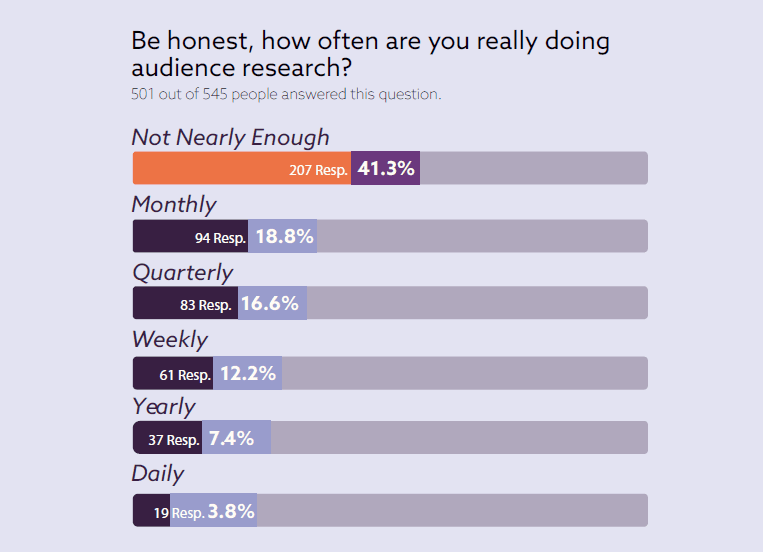Audience Research in the Wild: How Expert Content Marketers Really Do It
Audience research sounds great in theory — until you’re juggling a dozen deadlines and trying to get one more piece out the door. But skipping it means flying blind. We talked to content marketers who’ve figured out how to make research doable: in small moments, scrappy formats, and everyday workflows. This is your no-fluff guide to doing audience research in the real world — the way it actually happens.

Audience research is like going to the gym.
You know it’s good for you.
You know you’re supposed to do it.
You’ve read, by this point, 200 versions of the “10 best exercises to get lean in 2025”/How to do audience research the right way.
And you’re going to get right to it. Just as soon as you’ve finished this bag of chips…I mean, this blog post due tomorrow.
If this is you, no shade. As Tommy Walker’s State of (Dis)Content Report so clearly showed, content marketers tend to be swamped, almost by default. Most content teams are tiny. Many are pulled in hundreds of directions at once.
But, just like the whole exercise thing, audience research really is good for you. Tommy’s report also showed that content marketers who are able to make the time for audience research are:
- More likely to get leadership buy-in
- More likely to be creatively fulfilled
- More likely to be satisfied with their career.
Plus, the risk of not putting the reps in is that you end up simply copy/pasting strategies that worked for another client/project/audience — and we all know how that ends up.
There are already a lot of fantastic guides on audience research best practice. This article is about what experienced content marketers are actually doing. How they fit research into packed calendars, nonexistent budgets, and sometimes nonexistent buy-in.
So, if you’ve been skipping audience research because it feels too time-consuming, or you just never seem to get around to it — this one’s for you.
Embracing minimum viable audience research
Most content marketers don’t research their audience before they create their content. In the State of (Dis)Content Report, the most common response to the question “How often are you really doing audience research?” was, tellingly, “Not nearly enough.”

In the report, Tommy hypothesized that content marketers are held back by:
- Lack of time
- Lack of training
- Lack of buy-in — either from leadership, or the marketers themselves
“Prioritizing [audience research] is tricky. There's always something 'more urgent,' but without it, content starts feeling like shouting into the void,” says Gordana Lasković, Community Manager at Collabwriting.
“Prioritizing audience research is tricky. There's always something 'more urgent,' but without it, content starts feeling like shouting into the void.”
James Leach, Content Manager at Omnipresent, says he also feels pushback from other departments, who are keen to protect client time: "My biggest barrier has always been, ‘This is a high value client, they're very busy right now.’”
Instead of trying to approach audience research as a formal, time-consuming project, it may be more realistic to treat it as part of the daily flow of work. “In reality, audience research often happens in micro-moments rather than full-blown initiatives,” says Yurii Shumak, Senior Content Marketing Manager at SDC Verifier.
“In reality, audience research often happens in micro-moments rather than full-blown initiatives.”
You don’t need a massive budget or research team to get insights that actually move the needle. A handful of real conversations can do more for your strategy than a 40-slide persona deck.
“Audience research is a scalable process,” explains Treasa Edmond, a content strategy consultant. “It depends on the client’s budget, timeline, and goals.”
“I break audience research into levels. At minimum: talk to real people — even five chats can shift your thinking. Mid-level adds surveys, focus groups, and pattern spotting. Top-tier? Layer it all with journey maps, segments, and behavior data from sales, CS, and UX.”
Treasa’s suggestion is to think of audience research in terms of levels:
“Minimum level: Always, always have at least some direct conversations with real people in the audience. One-on-one interviews, DMs, email replies — whatever I can get. Even five short chats can shift how I think about messaging and content.
Mid-level: Individual interviews, focus groups, surveys (with actual data analysis), and social listening. I’ll also look at reviews and public conversations to identify patterns in pain points or priorities.
Top-tier: A combo of the above, plus deeper segmentation — creating personas, mapping buyer journeys, and layering in behavioral analytics or CRM data if the client has it. UX teams and insights from customer success and sales come in here too.”
Start scrappy. Get what you can. Build from there.
Talking to the people who talk to your audience
You don’t need to go straight to the audience to get great insights — sometimes the best intel is sitting right across Slack.
“The best system for any content writer is a meeting cadence (I know, we all love adding meetings to our schedules) established within the revenue team,” says Maxwell Pollock, the Content Marketing Manager at WRS Health.
“The best system for any content writer is a meeting cadence established within the revenue team.”
“Ideally, content marketers should sync with a leader from sales as well as account management to ask questions, understand current objections, and identify sales blockers.”
Of course, he acknowledges, “Sometimes, that's a luxury.” If you can’t get regular conversations with the rest of the GTM team (say, you’re a freelancer and that kind of access is out of your reach), Maxwell suggests asking for access to the CRM or even looking at activity notes in tools like HubSpot, where you can trace the customer journey in detail.
Yamon Y., Senior Content Marketing Manager at Whatagraph, stresses the importance of talking to multiple salespeople to get a varied take on audience interests:
“For me it's an AE and a SDR. They have different viewpoints and experiences so it's important to talk to both. For example, AEs know more about ‘Aha’ moments and direct feedback during product showcases, while SDRs know more about pain points.”
“I talk to both AEs and SDRs — their insights are different, and both matter. AEs see the ‘aha’ moments in demos. SDRs hear daily pain points. That mix is gold for writing product-led content.”
She also advises talking to customer success managers:
“They are the ones who are talking to actual customers on a daily basis about the product and what customers like / don't like about it, and it's SUPER important to have that insight to write product-led articles.”
Belinda Roozemond, senior content writer, also likes to gather internal input from the wider team to get the full picture:
“I try to sit in on calls with stakeholders from different departments (legal, IT etc.). This gives me a great way to understand their different needs at a variety of touchpoints.”
Another handy tip: Mary Scott Manning, Senior Content Manager at Domo, does "mini interviews" with internal folks who match her audience — a fast, clever workaround when external access is limited.
Becoming a fly on the wall
When you can’t talk directly to your audience, eavesdrop instead. Specifically, look for the advice they seek out and give each other, recommends Rachel Burns, Senior Content Marketing Manager at Calendly:
“Sometimes that's on LinkedIn, sometimes on subreddits, and sometimes in more niche communities, but you can learn a lot about someone's pain points and the language they use by seeing how they either ask for or give advice from/to others who have been in their shoes!”
“When you can’t talk to your audience, eavesdrop. The way they ask for and share advice reveals their pain points and the words they actually use.”
This kind of passive listening can be relatively quick, and it doesn’t just help with building a more relevant content strategy. It can also help you find the right words and really get into your audience’s head, says marketing strategist and podcaster Vienna DeGiacomo:
“I will read, log, and analyze just about every relevant audience-written comment, communication, social post I can find! I want to marinate my brain in their words and language to start to find trends and themes so I can reverse engineer strategies and content that actually meets them where they are.”
Making audience research a habit
“The more we treat audience research as a built-in habit rather than a separate ‘project,’ the better it scales,” says Yuri.
“Document everything. Record calls, take notes, and brain dump it all somewhere accessible. It’s the key to writing with insight — and onboarding others who need it.”
For example, Yamon stresses the importance of good knowledge management habits:
“Document EVERYTHING you learnt. Record your calls and take notes. Then brain dump everything you learnt into a doc or a page on your company's project management tool. People don't often mention this part but documentation is absolutely key to refer back to the insights whenever you're writing an article, or to onboard new writers.”
Jordan Friedman, Director of Content and Communications at MasteryPrep, points out that every conversation with clients is also an opportunity for further audience research:
“When I speak with customers for case studies or success stories, I spend the last 2-3 minutes of our conversation picking their brains on what content channels they are most (and least) active on and why, and also ask them how they first heard of the organization.”
One small tweak Jordan recommends? Add a field to your lead forms asking, “How did you hear about us?” It’s low-lift, high-return.
“Customer research is biz dev. It’s about having real conversations, learning what’s happening on the ground, and building relationships while gathering intel.”
As an agency owner, Optimist Strategy Director Tyler Hakes points out,
“Customer research is essentially a biz dev function. I’m out having conversations with folks in the market, learning about their roles and trying to get a sense of what challenges and conversations are happening in the market. It works as both a way for us to get first-hand intel from our ICP and also helps nurture potential future client relationships.”
Yuri even uses AI to cluster and synthesize insights when time is tight. The goal isn’t to build a giant research report. It’s to keep learning on the go.
Time to hit the gym
Audience research doesn’t have to be an hours-long ordeal. You don’t need a research department. You don’t need a fancy framework.
You just need to start.
Talk to Sales. Skim Reddit. Ask two extra questions on your next customer call. Write down what you learn. Keep a doc. Build a little muscle.
To quote Treasa, “Anything is better than nothing, but more is better.”
And, if you need a little help, you might want to check out Relato. While no tool can replace strategic thinking, we’re here to help you free up time, cut the clutter, and focus on what really matters — understanding your audience and building content that connects.